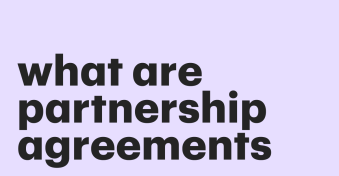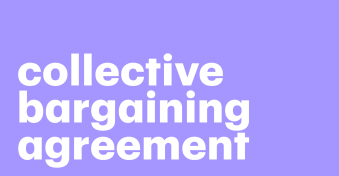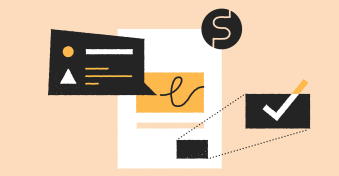When two parties reach a zone of possible agreement (ZOPA) during a negotiation, they’re more likely to ink out a deal because their goals and perceived outcomes align.
But when negotiating with professional corporate hagglers or overtly stubborn customers, reaching a reasonable middle ground becomes a herculean endeavor.
In this article, we’ll show you how to drive every negotiation into the zone of possible agreement without compromising on values and profit.
Key takeaways
- The zone of possible agreement is a bargaining range where the negotiators for different sides find intersecting interests.
- If the zone contains common goals, it is considered a positive bargaining zone. Otherwise, it is called a negative bargaining zone.
- Some challenges to establishing a ZOPA include uncooperative negotiators, changing market conditions, and pricing limits.
What is a zone of possible agreement?
The zone of possible agreement (ZOPA) is a bargaining range that contains common goals between two negotiating parties.
This bargaining range is usually earmarked by a price range, delivery dates, scope of services, SLAs, roles and responsibilities. It is also called a bargaining zone.
Negative bargaining zone
Any area outside the ZOPA is the negative bargaining zone.
If the negotiations get stuck here, both parties won’t be able to reach a deal.
The initial rounds of negotiations usually end up in a negative ZOPA.
All involved parties use this opportunity to lay out their cards and figure out what the other party has to offer.
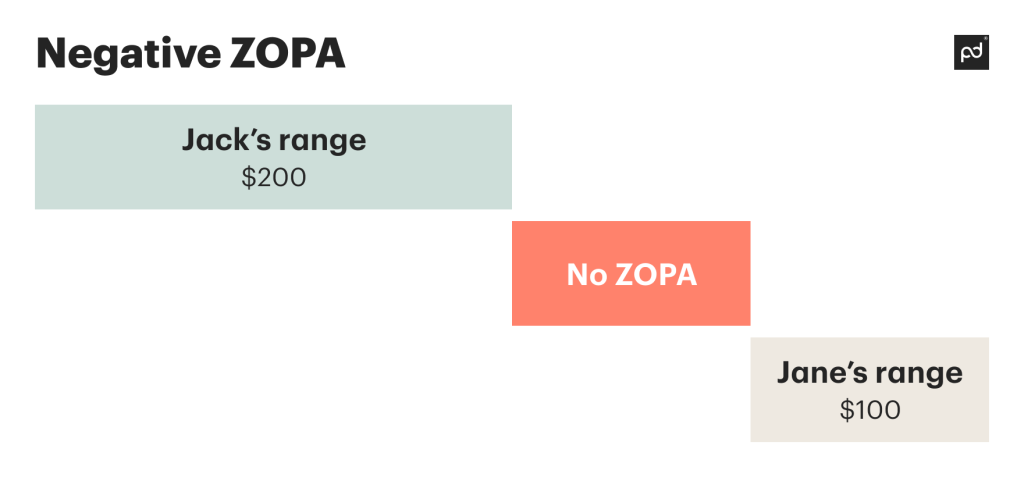
For instance, if Jack wants to sell his older iPhone for $200, but Jane only wants to pay $100, they are in the negative bargaining zone. Jack is stuck with the iPhone.
Positive bargaining zone
If both sides reach some common ground with overlapping interests, then they’ve entered a positive ZOPA.
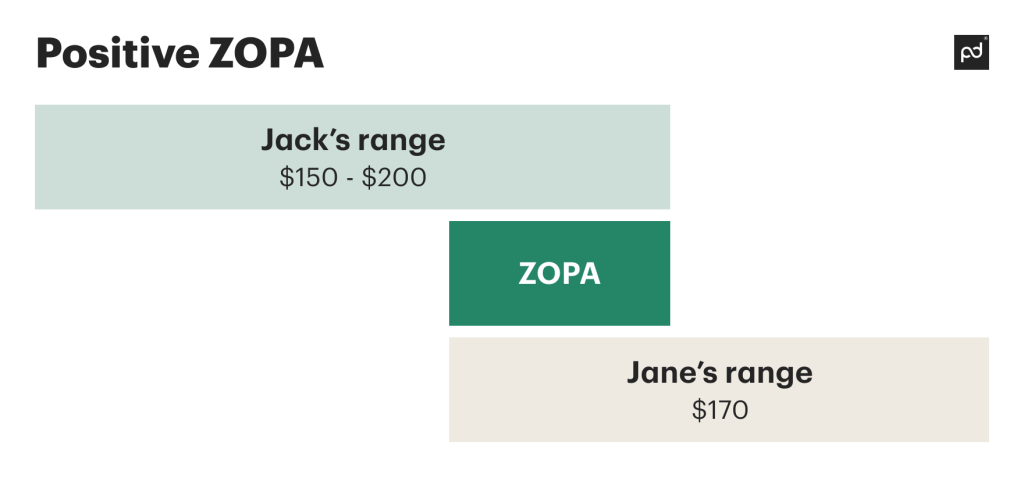
Let’s say Jack is looking to sell his iPhone in the $150 — $200 range, and Jane is willing to pay $170 — they are now in the positive bargaining zone. Jack can sell the iPhone to Jane without regrets.
BATNA vs WATNA
BATNA is the “best alternative to a negotiated agreement” used for getting the best deal from a deadlocked negotiation.
WATNA is the exact opposite: the “worst alternative to a negotiated agreement.”
Most negotiations come with a “fixed pie” — an acceptable range beyond which either party is willing to bulge. But BATNA offers wiggle room for mutual compromise beyond this reservation point.
In the iPhone example mentioned earlier, if Jane wants to pay $120, but Jack’s final price is $140, the BATNA can push them out of the negative ZOPA.
So instead of getting stuck without selling the phone, Jack could decide to add a charging cable as part of the deal.
If Jane rejects the revised deal — the worst possible outcome — then it is a WATNA.
How to hit the zone of possible agreement in negotiations
To enter the ZOPA, you need to plan out and be prepared to execute your negotiation playbook to the letter.
This way, you’ll be positioned to convince the other party that the deal you’re offering is the best on the ground.
Let’s discuss how to drive negotiations into the ZOPA.
Conduct in-depth research
Before getting to the negotiation table, acquire as much information as possible. This will give you additional leverage — always a good thing.
Here are some questions to guide your research:
- What are the risks of walking away without a deal (WATNA)?
- What offerings can you offer to spice up the deal?
- Is the other party a tough or reluctant negotiator?
- How desperate is the company or other entity for your services?
- What are the trade-offs or walk-away conditions?
- What other competing offers are available?
- Who is the other party’s representative?
Find the BATNA
The BATNA will help you end up with a win-win resolution even if no ZOPA exists between you and the other party.
The key is to remain flexible with your conditions and adjust all the parameters of the deal to make sure you stay within the zone of profitability.
And since you don’t know the other party’s BATNA, you need to establish walk-away positions beyond which no deal can happen in your favor.
Prepare for curveballs
Negotiations are never linear and straightforward, especially in dynamic economic or political scenarios.
Humans and natural events are always unpredictable; that’s why you need to prepare for unforeseen scenarios — those that favor you as well as those that may work against you.
For example, say you are negotiating for a role with a potential employer, and you get insider info that they desperately need your services — this information will help you take a firmer stance during your salary negotiation.
However, you must be prepared for other possible situations as well.
For instance, imagine you are negotiating a construction contract for a duplex with a potential client, but a new competitor offers them a cheaper deal outside your ZOPA.
In this scenario, you can invest more effort and resources into persuading the prospective customer that your construction company’s services are superior.
For example, you can absorb the cost of roofing to tip the scales in your favor. If not, the client will likely ink a deal with your competitor.
Be firm but flexible
Some clients will poke and prod to see if you’ll blink first and go beyond your ZOPA. That’s why you need a solid, package deal explaining why your offer is the best that client will receive.
During the 2023 WGA (Writers Guild of America) Strike, Hollywood writers unanimously refused to go to work until their demands were met.
Despite external pressure and financial chokeholds on individual members, the WGA persisted.
Subsequently, the negotiations ironed out favorable terms with improved working conditions and pay for writers. Not the best of negotiation outcomes, but definitely satisfactory for everyone involved.
Why do you need ZOPA negotiations?
Marketers, contractors, politicians, business owners, and professional negotiators need to understand their ZOPA before going into any contract negotiation.
This will help them reduce the time it takes to finalize a deal or walk away from a dead-end, bad-faith negotiation.
Here are the benefits of ZOPA negotiations:
- They help both parties get the best deal possible.
- They reduce the time spent on negotiations by focusing on areas of possible convergence.
- Finding your ZOPA helps you stay profitable at either end of the bargaining range.
- If successful, your ZOPA with one client could provide you with a playbook for similar negotiations.
Challenges in finding the ZOPA
The human factor is the main challenge in finding the ZOPA. Customers will intentionally lowball you and drive the negotiation into the negative bargaining zone.
Similarly, fierce negotiators will not meet you in the middle until they’re convinced you’ve reached a red line. Although most business negotiations go this way, it is a nightmare for time-sensitive deals.
In some cases, the supposed negotiator is on a “price fishing” expedition without any intention of closing a deal — wasted time and wasted efforts. These people are called bad-faith negotiators.
Moreover, hitting the pricing sweet spot can also be a massive headache. You need to conduct a SWOT analysis and competitor research to figure out a pricing range that works.
Besides, most ZOPA negotiations rely on guesswork and your ability to read the other negotiator.
And when you don’t know their BATNA, guaranteeing a successful negotiation might seem practically impossible.
ZOPA negotiation tactics that come in clutch
For ZOPA negotiations to succeed, you need to follow some best practices and align your action plan to your intended goals.
Here are some expert tips for ZOPA negotiations.
- Hire a representative with excellent and industry-relevant negotiation skills.
- Don’t name a pricing range. The other side will always go for the minimum.
- If applicable, approve the limits of the positive bargaining zone with your superiors beforehand.
- Acknowledge competitors but prove why you outclass them.
- Use contract management solutions to handle negotiations.
- Determine if the deal can go through as early as possible.
- Start with common interests and intersecting demands.
- Don’t stop asking questions about the other party.
- Treat the other side with respect and patience.
- As the seller, lay down the pricing marker first.
- Personalize the negotiations with small talk.
- Reject deals that don’t favor you.
Handle negotiations like a boss with PandaDoc
You can find and expand your zone of potential agreement by understanding the other negotiating party and aligning your goals with expected outcomes.
To carry out negotiations and redline contracts with consummate ease, you need a document management solution.
PandaDoc provides software solutions that will help you negotiate contracts.
As your ZOPA expands, you will be able to track all the changes to the contract. This will protect your bottom line and profit margin.
After negotiations, all involved parties can use our eSignature solution to seal the deal.
This application gives you access to custom drag-and-drop fields as well as click-wrap solutions.
To learn more about how PandaDoc can help you with ZOPA negotiations, book a demo.
Disclaimer
PandaDoc is not a law firm, or a substitute for an attorney or law firm. This page is not intended to and does not provide legal advice. Should you have legal questions on the validity of e-signatures or digital signatures and the enforceability thereof, please consult with an attorney or law firm. Use of PandaDoc services are governed by our Terms of Use and Privacy Policy.
